
Fredericka Carolyn "Fredi" Washington was an American stage and film actress, civil rights activist, performer, and writer. Washington was of African-American descent. She was one of the first black Americans to gain recognition for film and stage work in the 1920s and 1930s.
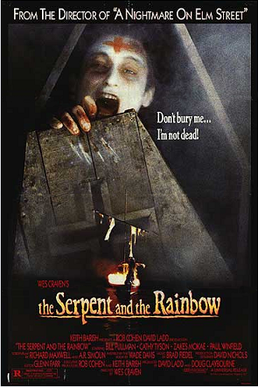
The Serpent and the Rainbow is a 1988 American horror film directed by Wes Craven and starring Bill Pullman. The script by Richard Maxwell and Adam Rodman is loosely based on the non-fiction book of the same name by ethnobotanist Wade Davis, wherein Davis recounted his experiences in Haiti investigating the story of Clairvius Narcisse, who was allegedly poisoned, buried alive, and revived with a herbal brew which produced what was called a zombie.

White Zombie is a 1932 American pre-Code horror film independently produced by Edward Halperin and directed by Victor Halperin. The screenplay by Garnett Weston, based on The Magic Island by William Seabrook, is about a young woman's transformation into a zombie at the hands of an evil voodoo master. Bela Lugosi stars as the zombie master "Murder" Legendre, with Madge Bellamy appearing as his victim. Other cast members include Joseph Cawthorn, Robert W. Frazer, John Harron, Brandon Hurst, and George Burr MacAnnan.
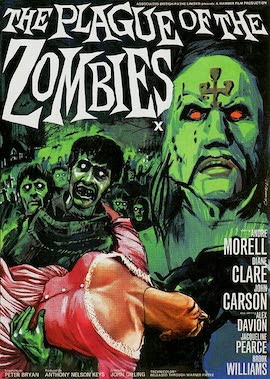
The Plague of the Zombies is a 1966 British horror film directed by John Gilling and starring André Morell, John Carson, Jacqueline Pearce, Brook Williams, and Michael Ripper. The film's imagery influenced many later films in the zombie genre.
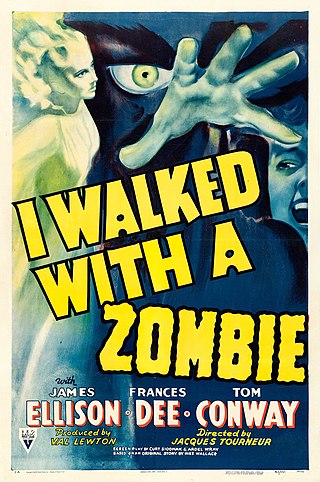
I Walked with a Zombie is a 1943 American horror film directed by Jacques Tourneur and produced by Val Lewton for RKO Pictures. It stars James Ellison, Frances Dee, and Tom Conway, and follows a Canadian nurse who travels to care for the ailing wife of a sugar plantation owner in the Caribbean, where she witnesses Vodou rituals and possibly encounters the walking dead. The screenplay, written by Curt Siodmak and Ardel Wray, is based on an article of the same title by Inez Wallace, and also partly reinterprets the narrative of the 1847 novel Jane Eyre by Charlotte Brontë.

The term Voodoo doll commonly refers to an effigy that is typically used for the insertion of pins. Such practices are found in various forms in the magical traditions of many cultures around the world.
Azaka Mede is the loa of the harvest in Haitian Vodou mythology. Another way to reference this loa is through the name "Azaka Médé".

Brother Voodoo is a character appearing in American comic books published by Marvel Comics. He first appeared in Strange Tales #169. The character was created by publisher Stan Lee, Roy Thomas, Len Wein, and artist John Romita Sr. Since replacing Doctor Strange as Sorcerer Supreme in The New Avengers #53, the character is referred to as Doctor Voodoo.

Voodoo Dawn is a 1991 American horror film directed by Steven Fierberg and starring Tony Todd, Raymond St. Jacques, Theresa Merritt and Gina Gershon. It was written by Jeffrey Delman, Evan Dunsky, Thomas Rendon and John A. Russo, and produced by Steven D. Mackler.

Zombie Nightmare is a 1987 Canadian zombie film produced and directed by Jack Bravman, written by John Fasano, and starring Adam West, Tia Carrere, Jon Mikl Thor, and Shawn Levy. The film centres around a baseball player who is killed by a group of teenagers and is resurrected as a zombie by a Haitian voodoo priestess. The zombie goes on to kill the teens, whose deaths are investigated by the police. The film was shot in the suburbs of Montreal, Canada. It was originally written to star mostly black actors but, at the request of investors, the characters' names were changed to more typically white names. While Bravman was credited as director, Fasano directed the majority of the film. Problems occurred between Fasano and the production crew, who believed him to be assistant director and ignored his directions.

Sugar Hill is a 1974 American horror blaxploitation zombie film, directed by Paul Maslansky and starring Marki Bey as the title character who uses voodoo to get revenge on the people responsible for her boyfriend's death. It was released by American International Pictures. According to the film, the zombies are the preserved bodies of slaves brought to the United States from Guinea. AIP had previously combined the horror and blaxploitation genres with Blacula (1972) and its sequel Scream Blacula Scream (1973).

Demoni 3 is a 1991 Italian horror film directed by Umberto Lenzi. It was written by Lenzi and his wife Olga Pehar, and the zombie makeup fx were handled by Franco Casagni. Lenzi said in later interviews that this was one of his favorite films, but he felt it was ruined by the low budget and some of the shoddy actors with whom he was forced to work with.

The Zombie is a fictional supernatural character appearing in American comic books published by Marvel Comics. The character was created by writer Stan Lee and artist Bill Everett for the standalone story "Zombie" in the horror-anthology comic book Menace #5, which was published by Atlas Comics, a forerunner to Marvel. The character later became well known for starring in the black-and-white horror-comic magazine series Tales of the Zombie (1973–1975), usually in stories by Steve Gerber and Pablo Marcos.
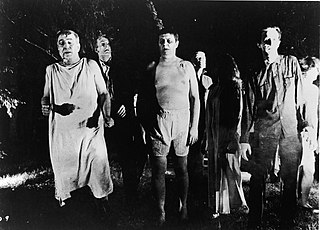
A zombie is a mythological undead corporeal revenant created through the reanimation of a corpse. Zombies are most commonly found in horror and fantasy genre works. The term comes from Haitian folklore, in which a zombie is a dead body reanimated through various methods, most commonly magical practices in religions like Vodou. Modern media depictions of the reanimation of the dead often do not involve magic but rather science fictional methods such as carriers, fungi, radiation, mental diseases, vectors, pathogens, parasites, scientific accidents, etc.
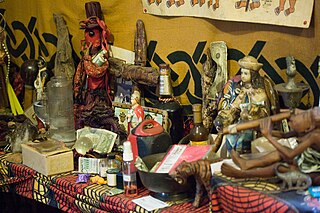
Louisiana Voodoo, also known as New Orleans Voodoo, is an African diasporic religion which originated in Louisiana, now in the southern United States. It arose through a process of syncretism between the traditional religions of West Africa, the Roman Catholic form of Christianity, and Haitian Vodou. No central authority is in control of Louisiana Voodoo, which is organized through autonomous groups.
The Dead One is a 1961 American independent horror film written, produced and directed by Barry Mahon. It stars John McKay, Linda Ormond, Monica Davis and Clyde Kelly. The narrative follows two cousins - one a businessman (McKay), the other a woman who practices voodoo (Davis) - who each seek control of their family's Louisiana plantation.

Voodoo Island is a 1957 American horror film directed by Reginald Le Borg and written by Richard H. Landau. The film stars Boris Karloff, with a cast including Elisha Cook Jr., Beverly Tyler and Rhodes Reason. It is set in the South Pacific and was filmed on Kauai, Hawaii back to back with Jungle Heat. Adam West appears in a small pre-"Batman" uncredited role.

Darby Jones was an American actor known for his role as the zombie-like Carrefour in the 1943 horror film I Walked with a Zombie. He appeared in a similar role in the 1945 film Zombies on Broadway. He had uncredited appearances in the 1937 films Swing High, Swing Low and A Day at the Races, and his other roles include Broken Strings (1940), Virginia (1941), White Cargo (1942), and Zamba (1949). Jones also appeared in several Tarzan films, including the 1933 film serial Tarzan the Fearless, and the films Tarzan Escapes (1936) and Tarzan's New York Adventure (1942).
Voodoo in popular culture encompasses various representations of practices associated with different forms of voodoo, including Haitian Vodou and Louisiana Voodoo, and other elements attributed to African diaspora religions, with such representations often deviating substantially from any actual voodoo practices or beliefs. Tropes regarding voodoo appear most often in supernatural fantasy or horror films, with common themes including the activity of witch doctors, the summoning or control of dark spirits, use of voodoo dolls to inflict pain on people remotely, and the creation of zombies.

The Magic Island is a book by American explorer and traveler William Seabrook. First published in 1929 by Harcourt, Brace & Company, The Magic Island is an account of Seabrook's experiences with Haitian Vodou in Haiti, and is considered the first popular English-language work to describe the concept of a zombie, defined by Seabrook as "a soulless human corpse, still dead, but taken from the grave and endowed by sorcery with a mechanical semblance of life—it is a dead body which is made to walk and act and move as if it were alive."

















